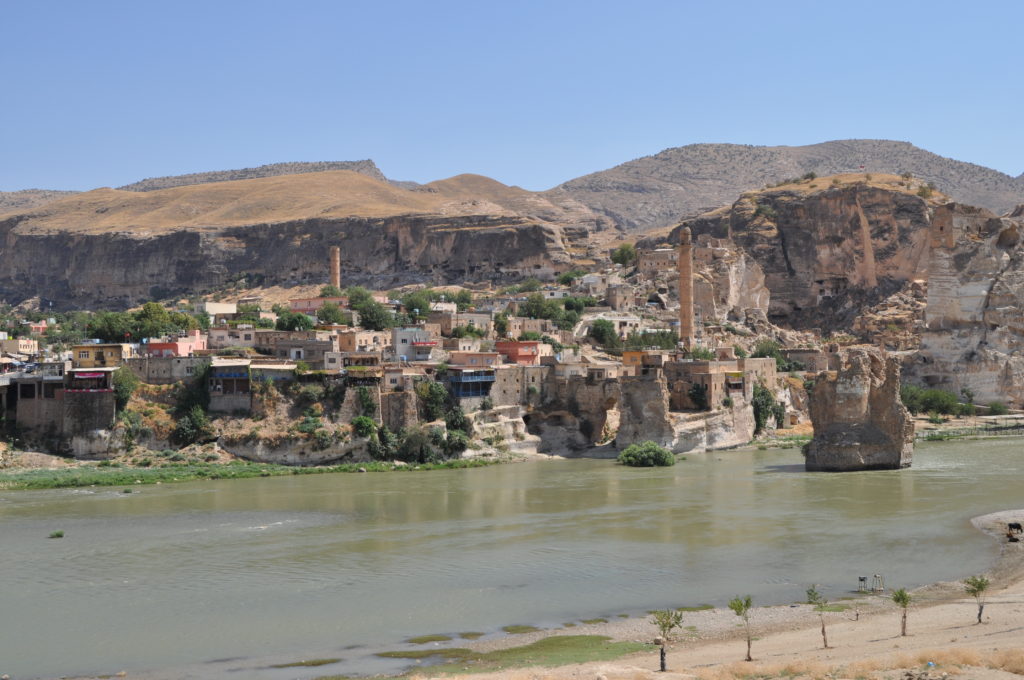Articles
Hasankeyf: a good bye to a millennial city
Article author: FUNCI
Date of publication of the article: 26/08/2019
Year of publication: 2019
Article theme: History, Human Rights, Nature, Sustainability.
Progress and development are two terms commonly used to justify the destruction of heritage and the environment by industrial societies. In a different time, the case of Hasankeyf and the Ilisu dam wouldn’t even have caught our attention. In a time of climate collapse, however, it has an outdated feel of catastrophic consequences. Let’s get in context, we are in the Upper Mesopotamia, in the East of Turkey, a few kilometers away from Iraq and Syria. Hasankeyf is a town of three million people located at the river banks of the Tigris. As pretty much everything in this region –according to the legend, here we found the paradise on Earth and the pass of Noah–, Hasankeyf has millennial roots and keeps the footprint of all the generations that have inhabited it, from the Hurrians in the Bronze Age, to the current Kurds. Its name is a mix of Arabic, hisn (fortress), and the Syriac kefa (rock), due to the almost six thousand caves carved in the hills that flank the magnificent Tigris.
But Hasankeyf is about to disappear. The demolitions have already begun, and, in a couple of years, everything will be flooded under the waters of a huge damn.

But Hasankeyf is about to disappear. The demolitions have already begun, and, in a couple of years, everything will be flooded under the waters of a huge damn. These events can be traced back to the 50s, to the times of developmentalism and of the megaprojects that left so many traces and whose environmental impact was not understood until several decades later. In the 60s, the Southeaster Anatolia Project (Güneydoğu Anadolu Projesi, GAP) projected the construction of two dams: that of Ilsu, which will tear down Hasankeyf, and the Cizre, smaller and still ongoing. When, after several hiatus and slow progresses, the construction of the Ilisu dam finally began in the 90s, the times of the manu military developmentalism were already gone, and the project faced a big backlash both from the population affected (in Turkey and Iraq), environmental campaigns, and, what was worse, by its international funders. The United Kingdom withdrew its funding in the year 2000, paralyzing the project until 2006, when the first brick was laid thanks to the commitment of Switzerland, Germany and Austria. Their contribution, however, was suspended in 2008 until the project met several environmental guarantees, something that has not happened yet.
But the international restrictions, in addition to the regionalist or nationalist nature that often acquired the local protests (let’s not forget that we are talking about the Kurdistan and a context of armed violence), instead of resulting in a questioning of the project, led to an opposite reaction: the project was presented as a patriotic commitment and a proof of the strength of the Turkeys State against external and internal pressures. In addition to this, we need to remember that water plays a key role in the geostrategy of the Middle East. In this regard, GAP, which affects the upper course of rivers Tigris and Euphrates, has revealed a formidable element of coercion of its neighbors, Syria and Iraq. This allows us to understand the proud and resigned attitude we perceived in Hasankeyf when we visited it several years ago. As if, despite the banners calling for protest and resistance, its people were aware of the small chances they had against this new aggression to the region, and, thus, were just saying its good byes.

The dam, a 2 Km length and 130 meters high structure, was finished in 2019, and it’s already being filled. A new Hasankey, made up of villas and residential blocks, is hosting its relocated population, or, at least, those who have decided to remain in the region, instead of emigrating completely. In this new city, a so called “cultural park” will exhibit some of the old town’s remains, such as the marabout of Zeynel Bey, transferred in 2017 with much pomp; the zawiya of Imam Abdullah, transferred in 2018; and part of the Eyyubi mosque.
When the construction of the Ilisu dam finally began in the 90s, the times of the manu military developmentalism were already gone, and the project faced a big backlash from the population affected, environmental campaigns, and, what was worse, by its international funders.
The official discourse speaks of progress, electric power and employment opportunities. It even refers to the tourist appeal that diving into a submerged city will have. On the other hand, its critics remember the catastrophic impact other similar pharaonic projects have had on the environment, especially when taking into account that the effects of the Ilisu dam have already been felt downstream, in Iraq. In this context, developmentalism, megalomania, and social engineering acquire today an overtone of dramatic revival.


